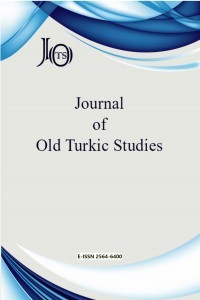Göz Hastalıkları ve Tedavileri Üzerine Eski Uygurca Sūtra’lardan Parçalar
Some Buddhist sūtras have sections on medicine. Two of them are related to eye diseases and their treatments. Each side of the fragments has 9 lines. The Fragments belong to Padmacintāmani-dhāraṇi-sūtra and Nīlakantakasūtra. In the article, firstly, they are transcribed and translated. Then, the names of the towns in the text were examined and compared with other works.
Anahtar Kelimeler:
Old Uygur fragments, Mainz 244, Mainz 212, Padmacintāmani-dhāraṇi-sūtra, Nīlakantakasūtra.
Some Old Uygur Fragments about Eye Diseases und their Treatments
Some Buddhist sūtras have sections on medicine. Two of them are related to eye diseases and their treatments. Each side of the fragments has 9 lines. The Fragments belong to Padmacintāmani-dhāraṇi-sūtra and Nīlakantakasūtra. In the article, firstly, they are transcribed and translated. Then, the names of the towns in the text were examined and compared with other works.
Keywords:
Old Uygur fragments, Mainz 244, Mainz 212, Padmacintāmani-dhāraṇi-sūtra, Nīlakantakasūtra.,
___
- Bailey, H. W. (1953). Medicinal plant names in Uigur Turkish. In 60. Doğum Yılı Münasebetiyle Fuad Köprülü Armağanı, Melanges Fuad Köprülü (pp. 51-56). Osman Yalçın Matbaası.
- Baytop, T. (1984). Türkiye’de Bitkiler ile Tedavi (Geçmişte ve Bugün). İstanbul Üniversitesi Yayınları.
- Bedevian, A. K. (1936). Illustrated polyglottic dictionary of plant names in Latin, Arabic, Armenian, English, French, German, Italian, and Turkish languages including economic, medicinal, poisonous and ornamental plants, and common weeds. Argus & Papazian Presses.
- Clauson, S. G. (1972). An Etymological Dictionary of Pre-Thirteenth-Century Turkish. Oxford University Press.
- Giles, A. H. (1912). A Chinese-English Dictionary I-II. Kelly and Walsh. (Revised & Enlarged)
- Laufer, B. (1919). Sino-Iranica; Chinese contributions to the history of civilization in ancient Iran, with special reference to the history of cultivated plants and products. Field Museum of Natural History.
- Mackenzie, D. N. (1976). The Buddhist Sogdian Texts of the British Library. Bibliothèque Pahlavi.
- Monier-Williams, S. M. (1899). A Sanskrit-English Dictionary, Etymologically and Philologically Arranged with Special Reference to Cognate Indo-European Languages. Motilal Banarsidass Publishing Hous.
- Müller, F. W. K. (1926). II. Reste einer sogdischen Übersetzung des Padmacintāmani-dhārani-sūtra. Sitzungsberichte der Preussischen Akademie der Wissenschaften. Phil.-Hist. Klasse 1926, 2-8.
- Rachmati, R. (1930). Zur Heilkunde der Uiguren [I]. Sitzungsberichte der Preussischen Akademie der Wissenschaften. Phil.-hist. Kl. 1930, 452–473.
- Rachmati, R. (1932). Zur Heilkunde der Uiguren II. Sitzungsberichte der Preussischen Akademie der Wissenschaften. Phil.-hist. Kl. 1932, 401–448.
- Reis-Habito, M. D. (1993). Die Dhāraṇī des Großen Erbarmens des Boddhisatva Avalokiteśvara mit tausend Händen und Augen. Übersetzung und Untersuchung ihrer textlichen Grundlage sowie Erforschung ihres Kultes in China. Routledge.
- Röhrborn, K. (1976). Fragmente der uigurischen Version des “Dhāraṇī-Sūtras” der großen Barmherzigkeit. Die Zeitschrift der Deutschen Morgenländischen Gesellschaft. 126, 87-100.
- Röhrborn, K. (1981). Uigurisches Wörterbuch. Sprachmaterial der vorislamischen türkischen Texte aus Zentralasien III. Franz Steiner Verlag.
- Sertkaya, O. F. (1989). Türkçe Tıp Metinlerinde Lületaşı. In Eskişehir II. Uluslararası Lületaşı ‘Beyaz Altın’ Festivali, “Beyaz Altın Semineri”, 23 Eylül 1989 (pp. 17-19).
- Tekin, Ş. (1965). Uygur Bilgini Singḳu Seli Tutung’un Bilinmeyen Yeni Bir Çevirisi Üzerine. Türk Dili Araştırmaları Yıllığı Belleten 1965, 29-33.
- Zieme, P. (1976). Sïngqu Säli Tutung-Übersetzer buddhistischer Schriften ins Uigurische. In Heissig, W. (Eds.), Tractata altaica: Denis Sinor, sexagenario optime de rebus altaicis merito dedicata (pp. 767-775). Harrassowitz Verlag.
- Yayın Aralığı: Yılda 2 Sayı
- Başlangıç: 2017
- Yayıncı: Erdem UÇAR
Sayıdaki Diğer Makaleler
Türk Bengü Taşları Örneğinde Anlam Yapısı Çözümlemesi
Der Einleitungsśloka zur „Lehrschrift über das Eintreten in den Abhidharma“ (T. 1554)
Cüveynî’nin Târîh-i Cihân-Güşâ Adlı Yazmasına Eklenen Sözlük
Göz Hastalıkları ve Tedavileri Üzerine Eski Uygurca Sūtra’lardan Parçalar
Budist Uygurlarda Abhiseka Ritüeli
Eine Gelehrte der Seidenstraße. Zum 120. Geburtstag von Annemarie von Gabain am 4. Juli 2021
